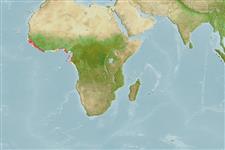>
Perciformes/Bembropoidei (Duckbill flatheads) >
Bembropidae (Duckbill flatheads)
Etymology: Bembrops: Greek, bembras, -ados = a kind of anchovy m+ Greek, ops = appearance (Ref. 45335); cadenati: Species named for J. Cadenat in recognition of his work on marine fishes off western Africa..
Environment: milieu / climate zone / depth range / distribution range
Écologie
marin démersal; profondeur 120 - 220 m (Ref. 13203). Deep-water
Eastern Atlantic: Gulf of Guinea.
Taille / Poids / Âge
Maturity: Lm ? range ? - ? cm
Max length : 16.4 cm SL mâle / non sexé; (Ref. 13203)
Description synthétique
Morphologie | Morphométrie
Épines dorsales (Total): 6; Rayons mous dorsaux (Total): 15; Rayons mous anaux: 18. Color in alcohol yellowish brown dorsally, lighter ventrally. Snout relatively short (1.2x eye diameter). Scales present laterally and dorsally on snout. Upper jaw extending behind anterior margin of eye but not reaching its mid-line. Maxillary tentacle medium-sized, slender. Lateral line descending gradually in posterior third of pectoral fin, separated from origin of first dorsal fin by 4 rows of scales, from origin of anal fin by 7, and from insertion of anal fin by 4. No evidence of prolongation of any spine of first dorsal fin. Predorsal length for first dorsal fin slightly higher than head length. Pectoral fin relatively pointed (Ref 13203).
Life cycle and mating behavior
Maturité | Reproduction | Frai | Œufs | Fécondité | Larves
Das, M.K. and J.S. Nelson, 1996. Revision of the percophid genus Bembrops (Actinopterygii: Perciformes). Bull. Mar. Sci. 59(1):9-44. (Ref. 13203)
Statut dans la liste rouge de l'IUCN (Ref. 130435)
Menace pour l'homme
Harmless
Utilisations par l'homme
Plus d'informations
Noms communsSynonymesMétabolismePrédateursÉcotoxicologieReproductionMaturitéFraiRassemblement de ponteFéconditéŒufsDéveloppement de l'œuf
Taille/ÂgeCroissanceLongueur-poidsLongueur-longueurFréquences de longueursMorphométrieMorphologieLarvesDynamique des populations larvairesRecrutementAbondanceBRUVS
RéférencesAquacultureProfil d'aquacultureSouchesGénétiqueElectrophoresesHéritabilitéPathologiesTraitementNutrientsMass conversion
CollaborateursImagesStamps, Coins Misc.SonsCiguateraVitesseType de nageSurface branchialeOtolithesCerveauxVision
Outils
Articles particuliers
Télécharger en XML
Sources Internet
Estimates based on models
Preferred temperature (Ref.
123201): 14.4 - 15.4, mean 15.2 °C (based on 5 cells).
Phylogenetic diversity index (Ref.
82804): PD
50 = 0.5000 [Uniqueness, from 0.5 = low to 2.0 = high].
Bayesian length-weight: a=0.00372 (0.00153 - 0.00904), b=3.10 (2.89 - 3.31), in cm total length, based on LWR estimates for this (Sub)family-body shape (Ref.
93245).
Niveau trophique (Ref.
69278): 4.0 ±0.4 se; based on size and trophs of closest relatives
Fishing Vulnerability (Ref.
59153): Low vulnerability (10 of 100).
